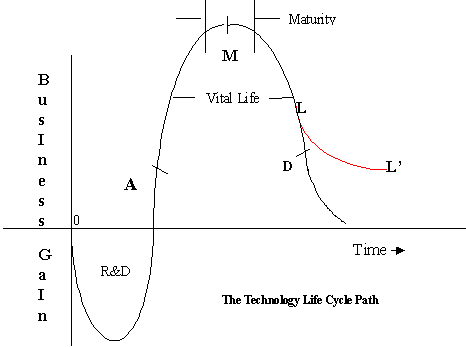
Back دورة حياة التقنية Arabic Cicle de vida de la tecnologia Catalan Ciclo de vida de la tecnología Spanish چرخه حیات فناوری FA מחזור חיי טכנולוגיה HE Ciclo de vida de uma tecnologia Portuguese 技術生命週期 Chinese
This article needs additional citations for verification. (August 2014) |

The technology life cycle (TLC) describes the commercial gain of a product through the expense of research and development phase, and the financial return during its "vital life". Some technologies, such as steel, paper or cement manufacturing, have a long lifespan (with minor variations in technology incorporated with time) while in other cases, such as electronic or pharmaceutical products, the lifespan may be quite short.[1]
The TLC associated with a product or technological service is different from product life-cycle (PLC) dealt with in product life-cycle management. The latter is concerned with the life of a product in the marketplace with respect to timing of introduction, marketing measures, and business costs. The technology underlying the product (for example, that of a uniquely flavoured tea) may be quite marginal but the process of creating and managing its life as a branded product will be very different.
The technology life cycle is concerned with the time and cost of developing the technology, the timeline of recovering cost, and modes of making the technology yield a profit proportionate to the costs and risks involved. The TLC may, further, be protected during its cycle with patents and trademarks seeking to lengthen the cycle and to maximize the profit from it.
The product of the technology may be a commodity such as polyethylene plastic or a sophisticated product like the integrated circuits used in a smartphone.
The development of a competitive product or process can have a major effect on the lifespan of the technology, making it longer. Equally, the loss of intellectual property rights through litigation or loss of its secret elements (if any) through leakages also work to reduce a technology's lifespan. Thus, it is apparent that the management of the TLC is an important aspect of technology development.
Most new technologies follow a similar technology maturity life cycle describing the technological maturity of a product. This is not similar to a product life cycle, but applies to an entire technology, or a generation of a technology.
Technology adoption is the most common phenomenon driving the evolution of industries along the industry life cycle. After expanding new uses of resources they end with exhausting the efficiency of those processes, producing gains that are first easier and larger over time then exhaustingly more difficult, as the technology matures.
- ^ group of authors (2015). Proceedings of IAC-MEM 2015 in Vienna. Czech Institute of Academic Education z.s., 2015. p. 91. ISBN 9788090579156.